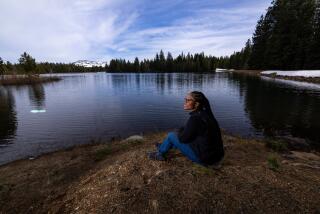Nature Conservancy Blazes Ranchers’ Path : Environment: Five years ago the group purchased a 1,600-acre spread on which it is testing less damaging ways to raise cattle--and showing them to neighbors.
- Share via
ASSOCIATED PRESS
ISLAND PARK, Idaho--It’s peaceful at Flat Ranch. The open grasslands rustle, the occasional cow bellows and rising fish make little plopping noises.
It’s an odd piece of neutral ground in the often sour relationship between ranchers and environmentalists.
The 1,600-acre ranch in Island Park was bought five years ago by the Nature Conservancy, an organization more famous for preserving land with rare animals or endangered plants.
Recently about two dozen Idaho ranchers piled into a wagon to see the results of a four-year experiment in raising cattle.
The ranch has been divided into 12 pastures. The cows are moved to a different one every three to 12 days so they don’t eat grass down to the nub. The pastures with streams haven’t been grazed for three years, giving plants a chance to grow back and shore up eroded banks.
“You can see it’s made a difference,” said Brad Orme, a fourth-generation rancher whose family owns 1,300 neighboring acres. “You look around and see all these things that you’d like to do, but usually it’s, ‘What can I do this year?’ ”
The Nature Conservancy has several goals for Flat Ranch: raise big, healthy cows, restore the streams on its land and assist other ranchers with the same interests.
Manager Allen May said the conservation organization wants to keep ranches in the West intact. They’re important open spaces that offer refuge for wildlife.
At the same time, changes need to be made to keep cows from trampling streams, causing erosion and damaging fish habitat.
“If we do all we can on our own ranch and walk away, we’ll have failed,” he said. “Because there’s a ranch upstream just waiting to be subdivided and turned into houses.”
Flat Ranch has gotten more than $40,000 in state and federal grants for improving water quality and wildlife habitat on farms and ranches. On average, the landowner has to contribute 25% of the cost.
That has paid to fence pastures, put a creek back in its natural banks and restore a wetland area that had been drained and left dry.
There are five spring creeks on the property that flow into the Henry’s Lake Outlet, a modest stream from the lake to Big Springs above the Island Park Reservoir.
These are the collective headwaters of the Henry’s Fork of the Snake River, one of the country’s more famous and visited rainbow trout fisheries.
The fish in the outlet, including native cutthroat trout, are threatened by warm water that flows out of the shallow lake, May said.
For $3,000, the ranch is putting in a new stock-watering system that will pull warm water out of the outlet for the cows. It had been drawn from one of the cold spring creeks, which help lower the water temperature.
“We want to see what works and doesn’t,” May said. “Every time you can leave cold water in the streams, it helps.”
There are 450 cow-calf pairs on the ranch this summer. So far the calves are meeting the weight gain goals--2 1/2 pounds a day for steers and 2 pounds per day for heifers.
The Flat Ranch is in a more comfortable position to experiment with its operation, said Ken Beckmann, district conservationist with the federal Natural Resources Conservation Service.
He helps ranchers in Fremont County apply for grant money and design improvement projects. The Flat Ranch is a good model to show ranchers what might be affordable and beneficial on their own land, he said.
“I don’t think a private rancher can take the risks and try new things like the Nature Conservancy does,” he said. “If they lose money on cattle this year, they’re not going to lose the ranch.”
May said he’s realistic about what other cattle ranchers can do. They don’t have time and volunteers to plant 3,000 willow trees along stream banks.
With some thoughtful planning, he said, a few well-placed fences can make a big difference in improving water quality.
On the banks of a stream where he’s pointing out the benefits of resting pastures, he sounds like a cross between a salesman and a preacher. That’s not so unusual in a conservation group that’s used to negotiations.
“We’ll take the headaches for you. If you don’t feel like dealing with the paperwork, we’ll make you a deal,” he said. “We even might open our checkbook if we think it’s a good enough project for the system.”
More to Read
Sign up for Essential California
The most important California stories and recommendations in your inbox every morning.
You may occasionally receive promotional content from the Los Angeles Times.













